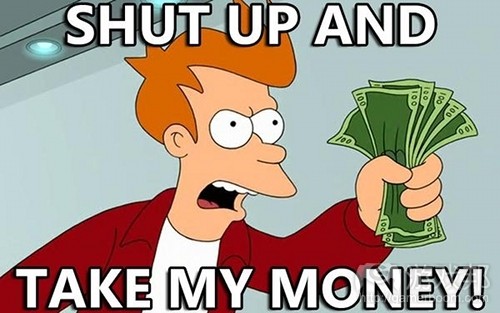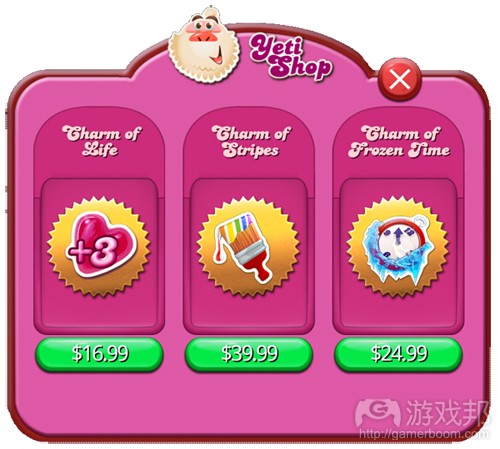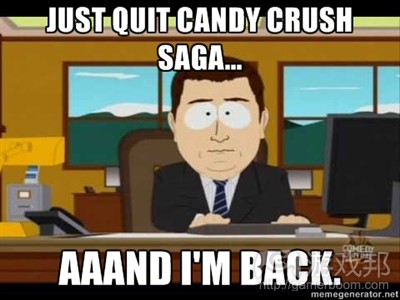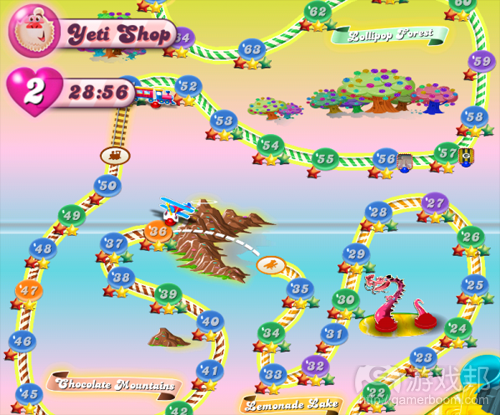解析《Candy Crush Saga》盈利机制与社交系统
作者:Sheldon Laframboise
关于《Candy Crush Saga》
《Candy Crush Saga》是一款设计过硬的连线消除游戏。它趣味十足,机制设计巧妙,并包含富有吸引力的玩法节奏。在我看来,它可以算是当今市场中连线消除游戏的典型代表。它是免费游戏,或更准确地说,应该是免费增值游戏。
本文主旨并非深入探讨该游戏设计的趣味性和娱乐性,在此我们将分析它的盈利机制,系统设计,及其免费增植模式的运行方式。
通俗性
《Candy Crush Saga》极具视觉亲和力,含可爱的角色,明亮的色彩以及令人愉悦的氛围。我想该游戏4600万的月活跃用户都会同意这个说法。
游戏设计vs社交/盈利系统设计
我说过本文不提游戏设计,所以我们就此打住吧。《Candy Crush Saga》是一款盈利机制和社交系统整合到核心体验,而非令核心体验迎合盈利机制、社交系统的游戏。当今有太多免费增值游戏就是采用了本末倒置的方法:
A)创造好游戏,然后再考虑免费增值模式;
B)在已有的盈利策略的基础上创造游戏。
B是一个比A更高效的方法,但这两者都会产生空洞的设计/体验,市场反应可想而知。《Candy Crush Saga》采用了“整体大于独立部分之和”的设计方式。其效果十分理想,截止本文撰稿,该游戏每月创收高达6200万美元。
转化机制:盈利系统
命值模式
这款游戏含有可怕的Zynga生命模式……但这没有关系。它是一个可行的系统,可通过禁止/限制玩法次数而保持游戏的新鲜感。该系统有助于增加玩家粘性,减少流失率以及玩法疲劳感。虽然游戏最初只为玩家提供 5条命,但已经足够玩家等地铁或公交车时打发时间。这个生命模式还整合到了游戏中的其他盈利和社交系统。玩家可以向好友发送和请求更多条命,或者花99美分重新填充生命条。
社交门槛
在玩家遇到社交门槛之前,他们可以体验游戏的35个关卡。你可能会问,什么是社交门槛?它就是另一种含多重功能的机制。它包括留存率、转化率以及意在增加日/月活跃用户的多个层面。我将在之后的环节中讲述社交门槛。
现在我只能强调这个机制的三大要素:
1.它会限制玩家的进一步游戏进展,并为其提供目标——解琐下一个章节!
2.如果玩家希望立即克服这一障碍,继续玩游戏,他们可以花0.99美元解决问题。
3.或者请求3位好友为其发送打开下一章节的门票。这样玩家就得等待好友回应,才能继续玩游戏。这里还有另外两点需要注意:
a.向现成好友发送门票请求是在执行一个社交反应(游戏邦注:详见以下的留存系统)。这会鼓励活跃玩家更频繁回到游戏。
b.玩家有可能邀请新好友加入游戏,这有助于增加游戏的月活跃用户数量。新用户意味着游戏有可能转化一名新的付费用户。
注意:这就是付费墙的演变。付费墙曾会要求玩家付费继续玩游戏。付费墙寿命短暂,因为它们会严重拉低游戏的粘性和留存率。
冲动消费——“我只差一点就好了”
经常听到有人说“该死,我就只差一点啊!我要是能再多动几步就可以打败这个关卡了……”于是就有人花钱再买了更多行动的机会,以免自己在这个关卡上再卡2周。
这是该游戏最易于促成玩家转化率的机制。已经通过游戏前35个关卡的用户一定经常遇到这种情况。而冲动的“额外5步”购买机制通常与命值系统,以及游戏的难度节奏相联系。当玩家遇到难度上升的情况,他们可以投入数天或数周努力打败一个关卡。
当他们最终接近目标时,会感到一种兴奋,而后却失败了,这就很容易促使其花钱继续玩游戏。
即使是菜单也在促进玩家转化率
你是否注意到了上图中的继续按钮会根据不同情况变化颜色?在玩家用完所有行动的失败关卡中,继续按钮“Play On”会从原先的粉色变为绿色。这是一个微小的变化,但却可引诱玩家下意识地去点击这个按钮。我自己就已经无数次执行这一操作。正如我之前的文章所言,你永远不能低估人类潜意识的力量。
易消耗的能量道具
易消耗的能量道具可以提供打败这些困难关卡的优势。玩家在按下Play按钮进入游戏之前就可以购买。易消耗能量道具在许多游戏的转化率贡献中占比达到60%。《Candy Crush Saga》将其所有的易消耗道具植入3个内容包中,以增加玩家的价值。该游戏在移动平台有三种能量道具包:
Color Bomb x3
以一个彩色炸弹开启关卡。彩色炸弹可以清扫任何与之匹配的糖果,或者同其他糖果结合制造更大特效。
售价:0.99美元
Striped and Wrapped x3
以一个条纹包装弹果开启游戏,条纹糖果可以爆炸两次,两次都能破坏其身边的3 X 3格子。条纹糖果可清扫匹配的阵列。
售价:1.99美元
Coconut Wheel x3
游戏在糖果阵列中加入了强大的椰轮,后者会向随机方向移动,创造匹配的糖果。
售价:3.99美元
符咒道具(仅适用于《Candy Crush Saga》铁杆玩家)
符咒的作用是减少游戏难度。如果玩家购买了符咒,就可以减少他们遇到的一些其他转化机制。换句话说,玩家会更易于打败关卡,他们会更少遇到命值系统,额外5步选项。因此符咒售价更高。
注:在单人玩家游戏中,付费获胜是可行方法。如果玩家不喜欢,可以不付费。
(这是早前的截图,现在游戏已经减少了Frozen Time这种符咒,以便减少成本,增加销量。)
*命值符咒
没错,你已经完全投入了这款游戏。但却发现5条命并不够满足你粉碎糖果的疯狂热情。你想获得更多条命一次玩个够吗?没问题!
你可以购买一个命值符咒,让自己获得更多命值。它可以让你的命值从5增加到8。
售价:16.99美元
*条纹糖符咒
它可以将任何糖转变为条纹能量糖。匹配其他糖果,或者结合其他特殊糖果创造更好的效果。为何这个符咒如此昂贵?因为它比额外5步行动更有威力,并且更易于消除关卡中的障碍。
售价:39.99美元
*Frozen Time符咒
它可以让你无论玩哪个基于时间的关卡,都不会发生倒计时的情况。这个符咒实际上消除了该游戏中多数计时型关卡的难度。
售价:16.99美元
留存系统
短小的玩法
《Candy Crush Saga》关卡很短,一般介于30秒至2分钟。其短小的玩法可以让玩家在最短暂的无聊时期打发时间。
精简的故事
该游戏实际上是一个故事:一个小女孩在糖果大陆中旅行,在途中帮助该大陆居民清扫障碍。
这个故事并无多大吸引力,但却给予玩家另一个游戏进程的目标:探索其余的故事内容。
进展和目标导向玩法
游戏中总是不乏挑战和目标。玩家要持续前行。持续的进展会让玩家自发重返游戏。以下是一些目标导向型玩法的典型:
*打败一个关卡
*打败“令人抓狂”的关卡
*在一个关卡中获得3颗星
*打败一个章节
*解琐新章节
*在一个章节的所有关卡中获得3颗星
*击败好友的高分
*在地图上追上好友的步伐
还有好多目标,《Candy Crush Saga》是一款进展无限的游戏。
地图
地图在玩家心理中扮演了一个重要角色。它让玩家获得更好的进程感,让他们知道自己在哪,将向何处去,好友在哪等情况。地图的社交整合也为游戏注入一种好友之间的小型竞争精神,让你准确看到好友所处位置,他们目前所在的关卡。它让你在轻松过关,而好友困在某个关卡2周时产生良好的感觉。
难度节奏降低玩家流失率
这里要注意另一个游戏设计。《Candy Crush Saga》是以其难度节奏为基础而创造。那些极令人受挫的高难度关卡之后,通常会紧跟5-6个简单至中等难度关卡。这种起伏变化的难度持续吸引玩家重返游戏。成就感是玩家进程和留存率的主要动力。
连续释放许多高难度关卡令玩家不堪重负,这只会让留存率下降。
完整而极致的社交绑定
如果你的好友在玩游戏,你很可能也会玩。所以《Candy Crush Saga》几乎每个层面的设计都整合了Facebook功能:
*在每个关卡呈现好友分数
*在地图上呈现好友在Facebook资料的照片,以及他们的最新进展
*向你的好友发送社交升级等消息
*赠送命值,以便玩家继续游戏
*社交门槛会增加好友的价值
毫无疑问:游戏的玩法因好友而获得提升。另一个值得注意的是,Facebook功能是与该游戏无缝整合。玩家无需离开游戏应用来接受或发送Facebook请求。这种无缝整合可确保最大化玩家粘性。通过将玩家留在游戏中,设计师可确保玩家不会因这社交媒介而分心。换句话说,无需离开游戏可以让玩家在游戏中投入更多时间,甚至是更多金钱。
社交反应
玩家可以向好友炫耀,发送易消耗道具,帮助他们解琐新章节。注:在此我希望你不排斥Facebook警告。你的好友会反复将你拉回游戏去帮助他们(或者帮助你)。即使你已经退出了游戏,好友还是会将你召回,以便帮助他们解决问题,既然你又回到了游戏,何妨再玩一把游戏呢?
社交门槛——3个游戏挑战
社交门槛的本质是给予玩家目标。解琐下一个章节。
所以我从恐怖的付费墙角度提到了社交检查点及其发展。但不要误会,社交检查点也存在瑕疵——它们仍会拉低玩家粘性和留存率。如果玩家等得太久,而好友却都不回应,或者不肯花费99美分解决问题,那么他们就很可能放弃游戏。
为解决这一问题,King最近添加了让玩家“玩游戏过关”的功能。这样玩家就有机会参与连续三天,每日一次的简单挑战。他们战胜了第3个挑战,就可以解琐下一个章节。这个机制有助于解决一些因社交门槛带来的问题。
总结
虽然我遗漏了许多内容,但我们已经不难看出《Candy Crush Saga》是一款表面看似设计简单,但却在游戏设计、社交和盈利系统中注入了许多深思熟虑的游戏。
这款游戏盈利甚为可观,所以仍然能保持盈利与趣味之间的平衡。(本文为游戏邦/gamerboom.com编译,拒绝任何不保留版权的转载,如需转载请联系:游戏邦)
Candy Crush Saga: A Sweet Journey into Monetization
by Sheldon Laframboise
The following blog was, unless otherwise noted, independently written by a member of Gamasutra’s game development community. The thoughts and opinions expressed here are not necessarily those of Gamasutra or its parent company.
Want to write your own blog post on Gamasutra? It’s easy! Click here to get started. Your post could be featured on Gamasutra’s home page, right alongside our award-winning articles and news stories.
Foreword: Why Write this Article?
The industry is changing, and we are all trying to keep up. Now I should mention, I don’t claim to have all the answers and may have missed some things. If so, please let me know – I love to polish my work. With that out of the way, read on brave adventurer…
The Game
By itself, Candy Crush Saga is a solid Chain reaction/Match 3 game. It has fun, well designed mechanics and contains engaging gameplay pacing. In my opinion it currently stands at the pinnacle of the match 3 genre. (And if you were to look at market saturation, I think the public would agree) I could easily see myself spending 99 cents or more as a “retail” game. But the game does not cost a cent; it is free – or more accurately put, it is Freemium.
I could go into depth on what makes this game so entertaining and its game design, but that is not what this article is about. We are here to talk monetization and this game is a shining example of systems design and why the Freemium model works. So let’s get to this!
Approachability. Everyone loves candy!
Candy Crush Saga is extremely approachable visually, with cute characters, bright colours and satisfying fanfare. If makes the game extremely approachable for anyone.
Yup.. like I said, it’s damn cute. 46 million active users per month agree.
Game Design meets Social and Monetization Systems Design
Alright, so I said I wouldn’t mention game design so I’ll keep this short. Candy Crush is a game built with its monetization and social system integrated into its core experience; not the other way around. So many freemium games today are designed in a backwards way of either:
A) Creating a game and then trying to push in a Freemium strategy as an after thought
or
B) Having a monetization strategy and trying to build a game around it.
B is more effective than A but both of these approaches tends to lead to a hollow sort of design/experience and the market reflects that. Candy Crush is a well rounded, coherent design that takes in a “sum is greater than the individual parts” approach. It works well… So well that it currently (at the time of me writing this) makes well upwards of $62 million per month.
Conversion Mechanics: Monetization System in Detail
The Life Model
That’s right, the game contains the dreaded Zynga life model… But that’s okay. It is a system that works and keeps the game fresh by restricting/limiting gameplay sessions. This system helps increase engagement, reduces burn-out and gameplay fatigue. While the game only offers 5 lives initially, it is usually more than enough to pass by time on that short subway or bus ride.
The life model also feeds into the other monetization and social systems of the game. A player can both send and request more lives from friends or can simply refill the life meter for a mere 99 cents.
Social Checkpoints
The game offers 35 levels before gating the player with a social checkpoint. What’s a social checkpoint you ask? The social checkpoint is another mechanic that has a multi-tiered function. It covers multiple aspects of retention, conversion and attempts to increase daily/monthly active users. I will cover more aspects of the social checkpoint in later sections.
But for now I’ll just highlight the mechanic, it does 3 main things:
1. It gates the player from progressing further and gives them a goal – Unlock the next chapter!
2. If the player wants to overcome this obstacle immediately and keep playing, they can pay 0.99 cents
3. Alternatively a player can ask 3 friends to send them tickets to open the next chapter. The player will then have to wait for their friends to respond to continue on. There are another 2 points here that I should mention:
a. Sending ticket requests to existing friends performs a social callback (this is covered in more depth in the retention section). This encourages active players to come back more frequently.
b. There is a chance players will invite new friends to the game which would help increase the monthly active users count. New users mean new chances at having a customer that will convert.
Note: This is an evolution of the Pay Wall. Pay Walls used to require players to pay to continue playing. Pay walls were short lived as they drove engagement and retention down drastically.
The Impulse Purchase – I WAS SO CLOSE!
So you play candy crush… you’ll understand when I make the statement “Oh god I was so close! I would have beat this level if I had one more move….” This is usually followed by brief internal swearing. Well you can buy 5 more moves so you aren’t stuck on that pesky level for another 2 weeks.
This is easily the most monetized aspect of the game driving the majority of player conversion. Anyone who has played the game past the first 35 levels has surely run into this… multiple times.
The impulse “5 Extra moves” purchase works hand in hand with the life system and more importantly the difficulty pacing of the game. When the player hits a difficulty spike, they can easily spend days or weeks trying to beat a level.
When they finally get close, get that surge of excitement and then fall short, it is much easier to convert them to continue playing.
P.S. Please kill level 97 with fire.
Even the Menu is Built to Drive Player Conversion
colourSwap
Have you noticed that the continue button changes colour depending on the situation? On levels where the player’s fail state is to run out of moves (Clear Jelly, Drop the ingredients or Earn a certain score) the continue button “Play On” changes from its usual pink to green. This is a small change but it entices the player to press the button subconsciously. I know I have done this action more than a few times. Like I’ve mentioned in my past article, you can never underestimate the power of the human subconscious.
Consumable Power-Ups
Consumable power-ups can help offer an advantage over those difficult levels. These can be purchased right before pressing the Play button to enter gameplay. Consumables can count for up to 60% conversion in many games. Candy Crush offers all of its consumables into bundles of 3 for added value to the player. There are 3 main power-up bundles available for use on mobile:
color_BombColor Bomb x3
Start the level with a Color Bomb. Color Bombs can clear whatever colour they are matched with or can be combined with other candies for even bigger effects.
Cost: $0.99
stripedBombStriped and Wrapped x3
Start the game with a Striped and Wrapped candy power-up. Wrapped candies detonate twice , destroying a 3 by 3 grid around them both times. Striped candies clear rows when matched.
Cost: $1.99
coconutCoconut Wheel x3
Add powerful Coconut Wheels to the to the candy mix. Coconut Wheels move in a random direction and create power-up candies along the way.
Cost: $3.99
Charms the Durable Whale items (Warning: For the hardcore Candy Crushers only)
Charms exist to greatly reduce the difficulty of the game. If a charm is purchased by a player, it will reduce the likelihood they will encounter some of the other conversion mechanics currently built in. In other words the player will have an easier time beating levels and they will encounter the life system, 5 extra moves option less frequently. With that in mind, Charm upgrades are priced at a high value.
Note: Pay to win is acceptable in a single player game. Don’t like it? Don’t pay.
SotreThis is an older screenshot, since it was taken the Frozen Time charm has been reduced in cost to spur more sales.
The Charm of Life
Alright, you play a lot. You are totally invested in this game. You are the Lord or Lady of crushing poor innocent candy. But wait, 5 lives just isn’t enough to carry on your candy smashing madness? Maybe you want to get more lives in that life pool? No problem!
You can purchase a charm to give you more lives permanently in your life pool. This charm is aptly named: The Charm of Life. It increases your life pool from 5 to 8.
Cost: $16.99
Charm of Stripes
Once a game, change any candy to a striped power-up candy. Match it to clear a row, or combine it with other special candies for even better effects. Why is this charm so expensive? It’s better than 5 extra moves and can make clearing levels a breeze.
Cost: $39.99
The Charm of Frozen Time
Any time based level you play, the time doesn’t count down while you look at which gems to match. This charm negates essentially the most difficult aspect of timed Candy Crush levels.
Cost: $16.99
Retention Systems
Bite-sized Gameplay
Candy Crush levels are short, typically between 30 seconds to 2 minutes long. It’s bite sized gameplay that you can indulge in even in the smallest windows of boredom.
Story Lite
There is actually a story in Candy Crush and while it’s not going to be winning literary rewards any time soon; it is important to note that there is one. Basically the story is as follows: A little girl is travelling through a land of candy. As she does, she encounters and assists its denizens along the way.
It’s not much and it isn’t compelling but it gives the player another progression goal: Discover the rest of the story.
Progression and Goal-oriented Play
There is always some challenge to overcome or something new to achieve. The player is constantly driving forward. This constant progression brings the player back to the game almost impulsively.
Some of the goal-oriented play is as follows:
• Beat a level
• Beat “that frustrating” level
• Get 3 Stars in a level
• Beat a chapter
• Unlock a new chapter
• Get 3 Stars in all the levels of a chapter
• Beat a friends high score
• Catch their friends on the map
And so on… Candy Crush is a progressive endless game which can be scaled easily.
The Map
The map plays an important psychological role for the player. It gives the player a better sense of their progress. Where have they been? Where are the going? Where are their friends?
Social integration into the map also breaths in a small competitive spirit amongst friends as you can see exactly where they are and what levels they are currently stuck on. It makes you feel good passing a level with ease that your friend has been stuck on for 2 weeks.
Difficulty Pacing reduces Player Burnout
Another game design note. At its core Candy Crush is built around its difficulty pacing. Those oh-so-frustratingly difficult levels are immediately followed up with usually 5-6 easy to medium
difficulty levels. This peak and valley difficulty pacing keeps players engaged and coming back. A sense of accomplishment is a primary driver of progression and player retention.
Overburdening the player with too many difficult levels in a row drives retention down.
Complete and Utter Social Integration
If your friends are playing, you’ll likely be playing. Simple as that. Candy Crush has integrated Facebook into almost every facet of its design:
• Friends scores are displayed on every level.
• Facebook profile pics of your friends litter the world map with their latest progress
• Social upgrades and power-ups galore to be sent to and from your friends
• Gifted lives so you can keep playing
• Social Checkpoints give your friends added value
It goes on, but needless to say: Gameplay is improved with your friends. Also another great thing to note is that Facebook integration is seamless and very smooth. The player does not even need to leave the app to receive or send Facebook requests. This seamless integration ensures maximum engagement. By keeping the player in the game, the designer ensures that the player cannot get distracted by their social media. In other words, not leaving the game keeps the player around to invest more time and possibly spend more money.
Social Callbacks
Players can brag, send consumable power-ups and help their friends unlock new chapters. Side note: I hope you like Facebook alerts. Your friends will repeatedly drag you back into the game to help them (or help you). Even if you quit Candy Crush, your friends will bring you back in there to help them and hey, once you’re there, why not crush some candies. Annnnd you’re back.
Social Checkpoint – 3 Game Challenge
Social Checkpoints at their core, give the player a goal. Unlock the next chapter.
So I mentioned social checkpoints and their evolution from the horrible pay wall. But don’t get me wrong, social checkpoints have flaws as well – they still drive player engagement and retention down. If the player waits too long for tickets from a friend and don’t want to pay the 99 cents, they are likely to abandon the game.
To address this, King.com recently added in the ability for the player to “Play to Progress”. The player is offered the opportunity once a day, for three days, to beat a simple challenge. Once the third challenge is overcome the next chapter is unlocked. This mechanic helps solve some retention issues with social checkpoints.
The Sweet Sweet Summary
I know I’ve missed a fair bit but as you can see Candy Crush Saga is a deceptively simple design with many layers of thought and consideration put into every aspect of its game design, social and monetization systems.
The game monetizes so much yet it still manages to find that sweet balance between fun gameplay and monetary conversion. So what do you think? Does Candy Crush offer enough sweet gameplay without needing a trip to the dentist? Thanks for the read.(source:gamasutra)

















































 闽公网安备35020302001549号
闽公网安备35020302001549号